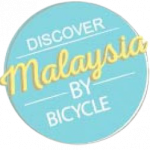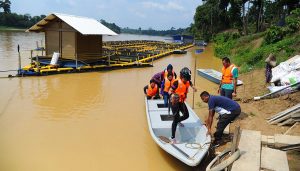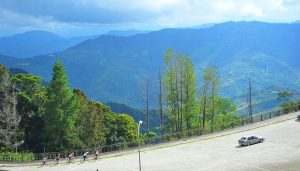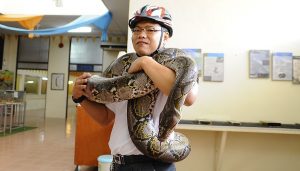Desaru invites you to see its waves crashing in and out. Take a dip in its shallow, clear waters, all 22km of it.
As the dawn broke into a vibrant orange, we stepped on our pedals. The cold crisp morning was perfect to start our journey. We had a long ride ahead of us. Our first destination was the Desaru Beach Resort, which took us about 69km south from Kampung Lukut.

Desaru Beach
The smooth roads were an easy ride with small hills of elevation every 10km. At a distance we could see the land was extending to the skies, with no trees or mountains afar. Excitement spurred further as we would hear the crashing of the waves becoming more audible as we drew closer. Once we paid a small sum of fee to enter the premise, our tires were slowly picking up the white sands of the 1. Desaru Beach. The switch from the dull tarmac road to soft sands jolted our muscles to pedal a little harder, but big smiles and laughter filled the air. We dipped our feet in the salty water that calmly touched us and enjoyed the surfing of the waves.

Tanjung Balau Fishermen Museum
The peaceful anthem of the sea insulated us with more energy to take on the road again. We cycled up 12km and reached 2. Tanjung Balau Fishermen Museum, a knowledge-infested place that centers on the humble lives of the fishermen and their legacy. The museum is erected on the Johor’s oldest fishing village. Founded by the fishermen who came ashore from Kelantan and Terengganu, this former site dates back to a century ago.
In 1995, the South-East Johor Development Authority (Kejora) opened the museum. You can hear the crashing of the sea waves as the museum overlooks the South China Sea, just meters away from the Tanjung Balau beach. Divided into several galleries, each springs up alive when you enter. Each gallery was refurbished to give the best real-life experience for knowledge seekers.

Semi life-sized boat

Artifacts
The Fishermen’s Gallery brings you around the tools used throughout the lives of the fishermen. Step inside the wooden houses built by the fishermen and you find yourself being transported back to the yesteryears. Walk out and you find yourself in a 3. Semi life-sized boat that moves according to the rhythm of the waves. 4. Artifacts abound with diorama, poster panels and photos were displayed, all rich in information and nostalgia.
Enter the Sea Gallery and you find yourself amidst the codes of the safety of the sea. On the main wall, you can see the universal flags of the sea that indicate the universal definition of each. You will also find new definitions to the 26 alphabets: Alpha, Bravo, Charlie and Delta learn the language of the sea masters. In a glass box, you would find a familiar black ship, lovers of the sea and pirates, you know it. Lo and behold, The Black Pearl comes to life bursting with a story. “The Black Pearl, originally Wicked Wench was a pirate ship which sailed in the Caribbean Sea in the early 18th century. Under the command of the notorious Pirate Captain, she attacked the Spanish Port of Puerto Dorado on Isla Tesoro. She was a Spanish vessel before she was captured by pirates and converted into a pirate ship.” Reading this prompts you to set sail to your own ship and you definitely get to play around with a ship navigator located just beside the glass box.
Then, step into the Geology Gallery and you will be thrown into the tragic shipwreck. Surround yourself with the corroded, broken items found when a ship sank off Desaru seawaters while carrying cargo for the European markets in the 1830s.
The last gallery leaves you feeling eerie. In this seasonal gallery that changes every three months, we found ourselves in the museum of coffins. We walked through a ghostly ambience with coffins erected from purely handmade woods for children who died of sickness or men who simply died of tragedy. You even find seated chair coffin for the ones who died at a ripe age. Buffalo and crocodile boneheads were carved on the head of the coffins that added to the strangeness of it all. It makes you think of the type of cultural anomalies practiced during the ancient times.

Desaru Fruit Farm
We exited the museum with a head full of imparted knowledge. We took a break, sipped on some energy drinks and made our way to the last destination. We cycled another 13km up to the famous 5. Desaru Fruit Farm. We entered the gates with happy greetings from the papaya trees. More fruit trees mushroomed as we cycled inside. The 180 acres of tropical fruit land was home to more than 100 tropical fruits and we just couldn’t wait to explore.

Local Fruits
We entered the dining area and almost fainted at the sight of fresh cut fruits spread out for us. Our mouth watered and our brains danced, too eager to eat them all, but not knowing where to begin. Each of us pierced our forks on to 6. Juicy mangoes, crispy watermelons, sweet papayas, and the famous passion fruits. For those who have only tasted passion fruits through their high-end passion fruit beverages or passion fruit flavored bubble teas, make no mistake as they are not even close to what you will taste. Scooping into the passion fruit, only to watch the yellow slushy flesh with visible dark green seeds slide off the inner villus-skin, was an extravagant sight. There’s no sweet heavenly taste, only sour, addictive taste. We saw hands snagging a piece after another, and each time, either grabbing a yellow or a vermillion red passion fruit. The only difference between both colors is that the yellow fruit springs with a sweet scent.

Ducks

Goats

Ostrich
We took our time devouring and appreciating the country’s tropical fruits. We then hopped on our bicycles to explore the vicinity. We halted at the mini zoo, bustling with farm animals. On one end, you find rabbits, and on the other, you find 7. Ducks. With 8. Goats bleating and baa-ing aloud alongside chickens clucking and roaming around, it all began to feel like a farm-wonderland. You even get to treat your eyes by just watching an 9. Ostrich going on about its day. The curious man may choose to get closer as he pleases.

Jackfruit
We even learned how to pick a 10. Jackfruit. The common rule to harvesting was, the fruit that branches out into three from the main branch would result in a deformed shaped fruit, thus to be rejected from selling. Perfect fruits come in healthy oblong shapes and extend to only one branch.
We were learning so much we didn’t notice the sky was slowly being blanketed in cerulean blue, indicating it was time to head home.
We completed the 94.33km bike ride with frequent but small elevations. This bike ride is only suited for the cycling enthusiasts, ones who could pedal long distances. This package gives you an eclectic ride where both your mind and tummy will get filled with Johor history and the bearings of Mother Nature.

Cycling Route – Desaru Fruit Farm Bike Ride
The cycling tour package is provided by: Executive Travel & Tours (M) Sdn Bhd (KPL 0511)
Lot 10A, Ground Floor, Anjung Neigbourhod Centre, 79250 Nusajaya Johor. Tel: +607 510 2821












